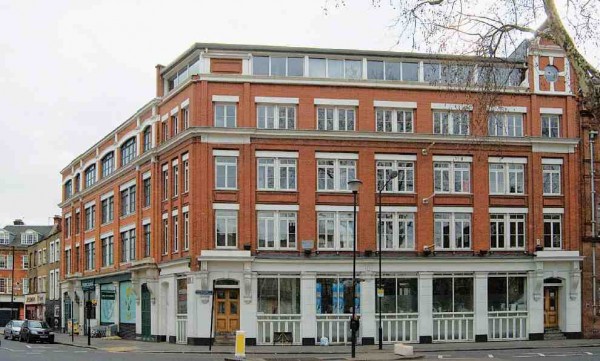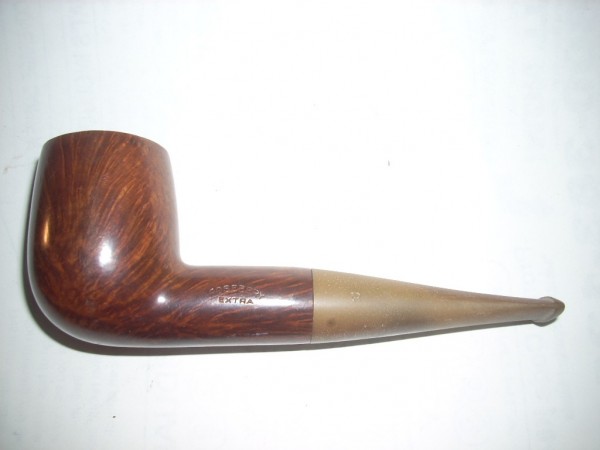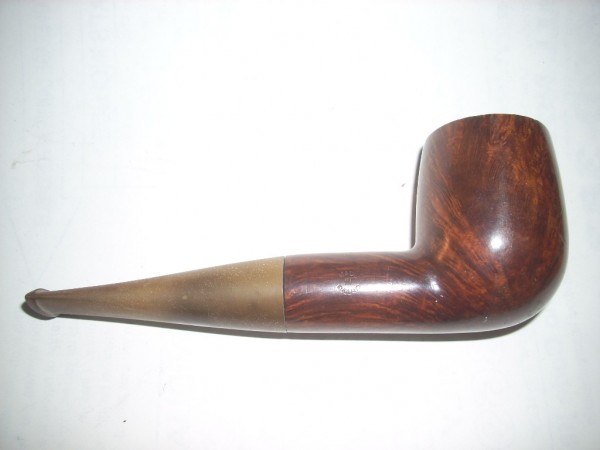This alone is enough for me to avoid bidding. I don't care how good you think you images are, nothing beats having the pipe in hand to inspect. It saves the headache of having to go through eBay's resolution procedures, if you need to deal with a recalcitrant seller, as "no return" policies are voided if the item is not as described.The seller does not accept returns
Fraudulent Comoy Blue Riband eBay listing
- Thread starter zulucollector
- Start date
You are using an out of date browser. It may not display this or other websites correctly.
You should upgrade or use an alternative browser.
You should upgrade or use an alternative browser.
SmokingPipes.com Updates
Watch for Updates Twice a Week
- Status
- Not open for further replies.
The stamping doesn't look photospped to me either. I have 20 years pro experience in photoshop and photo work.
John Adler (former president of Comoy) told me that there was no such thing as a cross grain Blue Riband. I specifically asked him with respect to a clarification of brand guidelines. That's how I know.
By the way, I think had a grand mal seizure with respect to the 110 shape number. It was originally introduced as a cutty then later reassigned to a billiard. I own both shapes.
It was my mistake.
It was my mistake.
Here is just one image of a Comoy Blue Riband stamp when photographed. (I could post tens of these if people want to see them). Notice that the light and color across the stamp are consistent. You don't see changes of light direction or refraction. Luminosity is consistent. In some places, the grain differentials are visible, but not everywhere.
Like some of the posters above, I have decades of experience with Photoshop. Putting the stamp on a photo is not difficult, but it is nearly impossible to keep luminosity consistent when photoshopping without a lot more work than is worth it. The image of the 110 on eBay does not have consistent luminosity across the stamp.
Maybe the image of the pipe for sale is unretouched, but it looks wrong to me.

Like some of the posters above, I have decades of experience with Photoshop. Putting the stamp on a photo is not difficult, but it is nearly impossible to keep luminosity consistent when photoshopping without a lot more work than is worth it. The image of the 110 on eBay does not have consistent luminosity across the stamp.
Maybe the image of the pipe for sale is unretouched, but it looks wrong to me.

Looking at this through a "sold listings" search, it looks like the photos were taken outside during a snow-fall, so lighting might look weird. At first, I though it was under a high-blue fluorescent tube until I saw the snowflakes. To me, it looks like a legit photo taken under odd lighting conditions with a lower-quality digi-cam, and then the quality was probably further degraded when hosted by Ebay. But, it sounds like there is still the question of the existence a cross-grain Blue Riband, so who knows? Not me! :puffpipe:
We'll get to see for sure in a week or so............ I bought the pipe.
I've also had several email exchanges with Jon, the seller. He bought this in Bridgnorth, Shropshire, at an auction. It was in a box with a teapot that he wanted. He kept the teapot, and listed this one and the other pipes. He said he's no photographer, a gardener actually............ nice fellow, and honest as the day is long.
I'm looking forward to this one....................
I wouldn't put 100% faith in the accuracy of what any president of any company tells you. That would be like the current president of Ford Motor Co. saying Ford NEVER made a brown car with red leather seats and a white steering wheel. Too many years, and too many units out the door, impossible to account for every single one........... Just my 2 cents...... : :
:
I've also had several email exchanges with Jon, the seller. He bought this in Bridgnorth, Shropshire, at an auction. It was in a box with a teapot that he wanted. He kept the teapot, and listed this one and the other pipes. He said he's no photographer, a gardener actually............ nice fellow, and honest as the day is long.
I'm looking forward to this one....................
I wouldn't put 100% faith in the accuracy of what any president of any company tells you. That would be like the current president of Ford Motor Co. saying Ford NEVER made a brown car with red leather seats and a white steering wheel. Too many years, and too many units out the door, impossible to account for every single one........... Just my 2 cents...... :
 :
:To me, it looks like a legit photo taken under odd lighting conditions with a lower-quality digi-cam,
That's exactly it.
Here's a direct quote from his email:
" i've got a little Samsung 120 camera on which the zoom doesn't work to well so just point and press. It seems that instead of being a gardener for the local authority, i missed my vocation in life as a special effects photographer!
Thank you for your comments on there, your exactly right i bought them all together at a local general auction in Bridgnorth (rural market town) in a box with a teapot i wanted for a Christmas present.
Have a happy Christmas, best wishes Jon."
That's probably the situation here.I wouldn't put 100% faith in the accuracy of what any president of any company tells you. That would be like the current president of Ford Motor Co. saying Ford NEVER made a brown car with red leather seats and a white steering wheel. Too many years, and too many units out the door, impossible to account for every single one.
The highest level people have the most credibility in their recollection of historical events and "how things were done," but the information they were EXPOSED TO was often filtered and/or modified BECAUSE of their high position. (The staff of VIP's try to protect them from too much information, as well as gain personal favor by being associated only with good news. It's a well-known phenomenon.)
In any event, we'll all soon know for sure, because bovineconsumer33 bought the pipe in question. :clap:
At the risk of beating a dead horse, let me try and explain yet again.
1. Blue Ribands were never made. They were selected from frased stummels in a sorting process after they had been made. They were selected according to qualitative criteria, principally that they had a straight, vertical grain orientation with good to outstanding grain. Adler said that the pipes were always "straight-grained or very good flame-grain." (from the interview transcript) It was the full-time job of those who sorted to determine which stummels went to which factories. Different lines were done in different factories. "Better bowls get put to one side. Certain workmen got the highest quality bowls. Bowls were turned in different factories than finishing."
2. The stummels were then shipped to the Rosebery "top-quality finishing shop" (quote: Adler interview) for finishing and stemming. Blue Ribands were given a contrast stain.
3. After having been inspected AGAIN for finish quality, they were stamped, post-finish, put in a Blue Riband sock and box, and then shipped. Adler said that the reason they were inspected after finishing is that the sanding and finishing process often surfaced flaws which would cause the pipes to be rejected. Final inspection was done by the Rosebery plant supervisor. That's how seriously Comoy took this process.
These pipes were in very high demand by collectors. Adler told me they could never produce enough of them, and that over time, declining briar quality forced the elimination of the line. Can you imagine the upset Comoy's factory and/or reps (and dealers) would encounter were they to ship out a Blue Riband with the wrong grain orientation, not to mention low-quality grain orientation? The people who bought these pipes knew what they were buying. Comoy didn't play games like that. It is one thing to have a low quality vertically-oriented grain pipe slip through. It is altogether something different to have a poor quality cross grain be selected in the sorting process. It simply won't happen, especially given the secondary, post-finish inspection.
Adler spoke about how important it was to Comoy to "retain high-quality, skilled people in the places they were." The best toolmakers were at Aldershot. The best finishers were at Rosebery.
Could someone have stamped the pipe with a Blue Riband stamp? It is possible. We know that this happened at the Dunhill factory and that Bill Ashton-Taylor actually counterfeited Dunhills. Stamping a pipe does not make it something it is not when that action contravenes Comoy policy. And, as Adler explained, there were fool-proof policies in place to ensure quality.
Finally, these were small companies. John Adler was not some elevated, removed executive with no knowledge of production. He could name the brands, and types of machines used on the factory floors, the processes, all of it. To suggest otherwise it pure balderdash.
You can put a Corvette badge on a Camaro, but that doesn't make it a Corvette.
1. Blue Ribands were never made. They were selected from frased stummels in a sorting process after they had been made. They were selected according to qualitative criteria, principally that they had a straight, vertical grain orientation with good to outstanding grain. Adler said that the pipes were always "straight-grained or very good flame-grain." (from the interview transcript) It was the full-time job of those who sorted to determine which stummels went to which factories. Different lines were done in different factories. "Better bowls get put to one side. Certain workmen got the highest quality bowls. Bowls were turned in different factories than finishing."
2. The stummels were then shipped to the Rosebery "top-quality finishing shop" (quote: Adler interview) for finishing and stemming. Blue Ribands were given a contrast stain.
3. After having been inspected AGAIN for finish quality, they were stamped, post-finish, put in a Blue Riband sock and box, and then shipped. Adler said that the reason they were inspected after finishing is that the sanding and finishing process often surfaced flaws which would cause the pipes to be rejected. Final inspection was done by the Rosebery plant supervisor. That's how seriously Comoy took this process.
These pipes were in very high demand by collectors. Adler told me they could never produce enough of them, and that over time, declining briar quality forced the elimination of the line. Can you imagine the upset Comoy's factory and/or reps (and dealers) would encounter were they to ship out a Blue Riband with the wrong grain orientation, not to mention low-quality grain orientation? The people who bought these pipes knew what they were buying. Comoy didn't play games like that. It is one thing to have a low quality vertically-oriented grain pipe slip through. It is altogether something different to have a poor quality cross grain be selected in the sorting process. It simply won't happen, especially given the secondary, post-finish inspection.
Adler spoke about how important it was to Comoy to "retain high-quality, skilled people in the places they were." The best toolmakers were at Aldershot. The best finishers were at Rosebery.
Could someone have stamped the pipe with a Blue Riband stamp? It is possible. We know that this happened at the Dunhill factory and that Bill Ashton-Taylor actually counterfeited Dunhills. Stamping a pipe does not make it something it is not when that action contravenes Comoy policy. And, as Adler explained, there were fool-proof policies in place to ensure quality.
Finally, these were small companies. John Adler was not some elevated, removed executive with no knowledge of production. He could name the brands, and types of machines used on the factory floors, the processes, all of it. To suggest otherwise it pure balderdash.
You can put a Corvette badge on a Camaro, but that doesn't make it a Corvette.
Comoys would be the only company I have heard of, employing humans, to have achieved total perfection in production. I am indeed impressed! A totally error free work place! Incredible. Unbelievable! In truth, I don't believe it.
I would believe the pipe is authentic before I would believe in perfection in production in any business. Certainly something to strive for, with the caveat that such is impossible.
I would believe the pipe is authentic before I would believe in perfection in production in any business. Certainly something to strive for, with the caveat that such is impossible.
An interesting thread. At least we'll be able to see the new owners photographs and opinion on the pipe, that rarely happens in these cases. That grain sure does look like a Tradition (as one of the Dave's commented)
Neill, did you ever get an opportunity to speak to anyone on the factory floor? I'm guessing some of those fellows (or ladies) might still be around, if a worker was in their 30's in the 1960's. Do we know what happened to the factory Blue Riband stamps? Were they a one-piece stamp or individual letters? I assume all the grades would have been one-piece, but I've never seen any reference to those stamps. Those would be priceless! (although no one would be able to replicate the 3 piece C to the factory specs).
Neill, did you ever get an opportunity to speak to anyone on the factory floor? I'm guessing some of those fellows (or ladies) might still be around, if a worker was in their 30's in the 1960's. Do we know what happened to the factory Blue Riband stamps? Were they a one-piece stamp or individual letters? I assume all the grades would have been one-piece, but I've never seen any reference to those stamps. Those would be priceless! (although no one would be able to replicate the 3 piece C to the factory specs).
Very interesting post Neill. Just out of curiosity, if you have an idea, how many people worked for Comoy's? We hear "factory pipes", and people start thinking Ford Motor Company, or General Motors, but I get the sense that these companies, Comoy's, Dunhill, Barling's, etc were relatively small.
Comoy's factory on Rosebery Avenue, London. "Nos 72–82 were home for more than 50 years from 1913 to H. Comoy & Co., briar-pipe manufacturers."

Comoy's factory on Rosebery Avenue, London. "Nos 72–82 were home for more than 50 years from 1913 to H. Comoy & Co., briar-pipe manufacturers."

Well, the pipe obviously exists. Whether it fell through the usual QC standards Neill describes is another question...Wait, so now the argument is that the image of the pipe was NOT altered -- only that the pipe itself doesn't actually exist (because Adler)?
Ah, good point. I think Warren might have mentioned something along those lines earlier. (Sorry folks, I'm a little slow on the uptake.) :DWell, the pipe obviously exists. Whether it fell through the usual QC standards Neill describes is another question...
- Status
- Not open for further replies.










